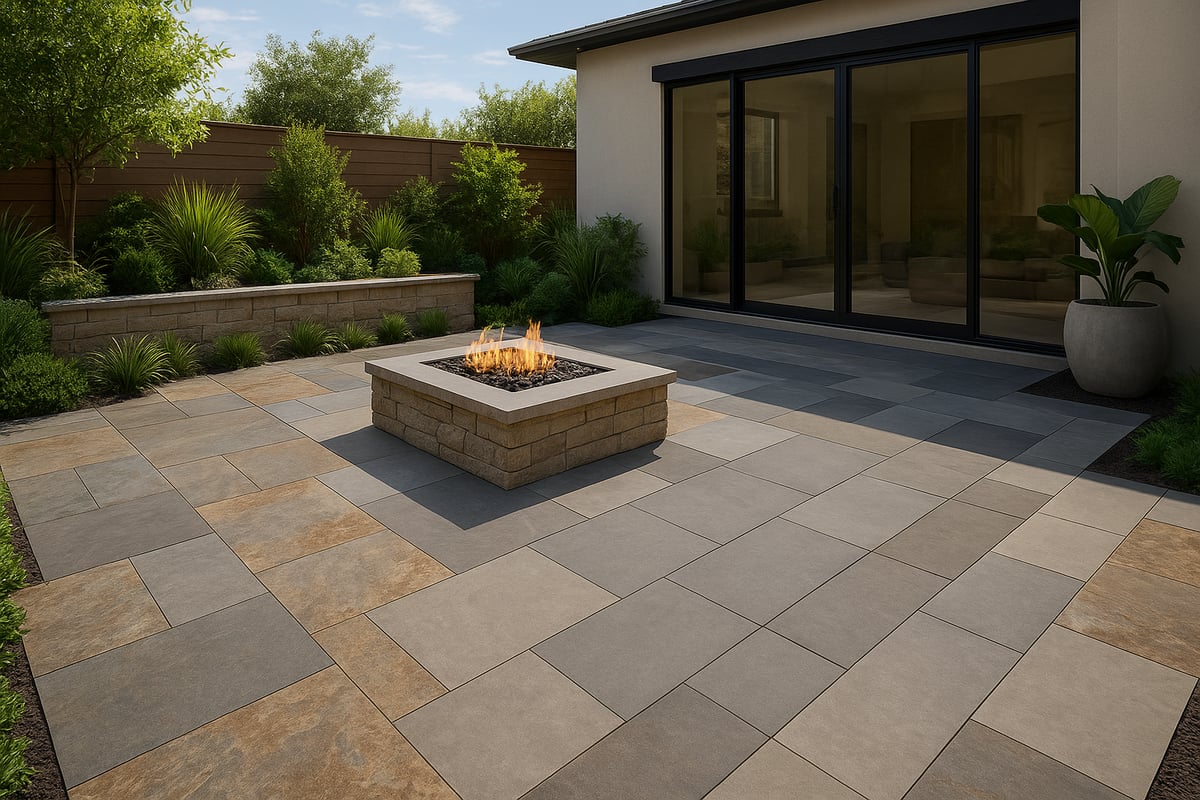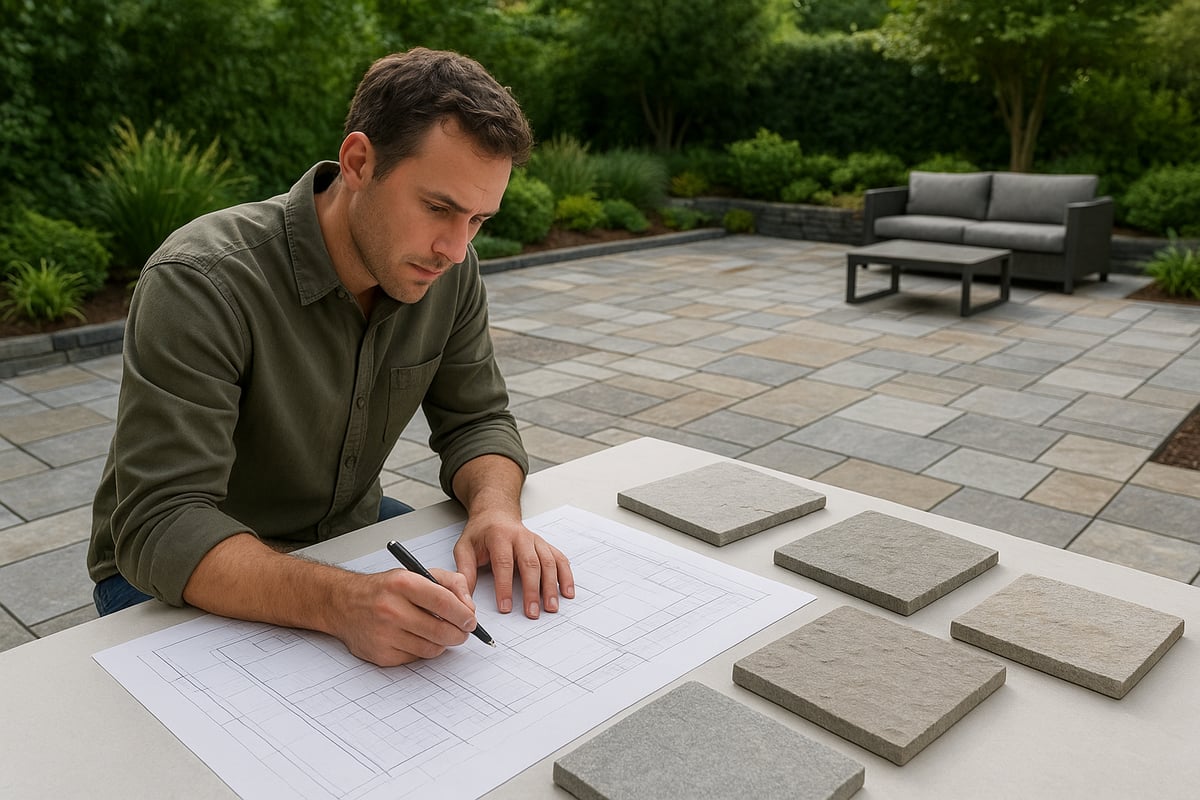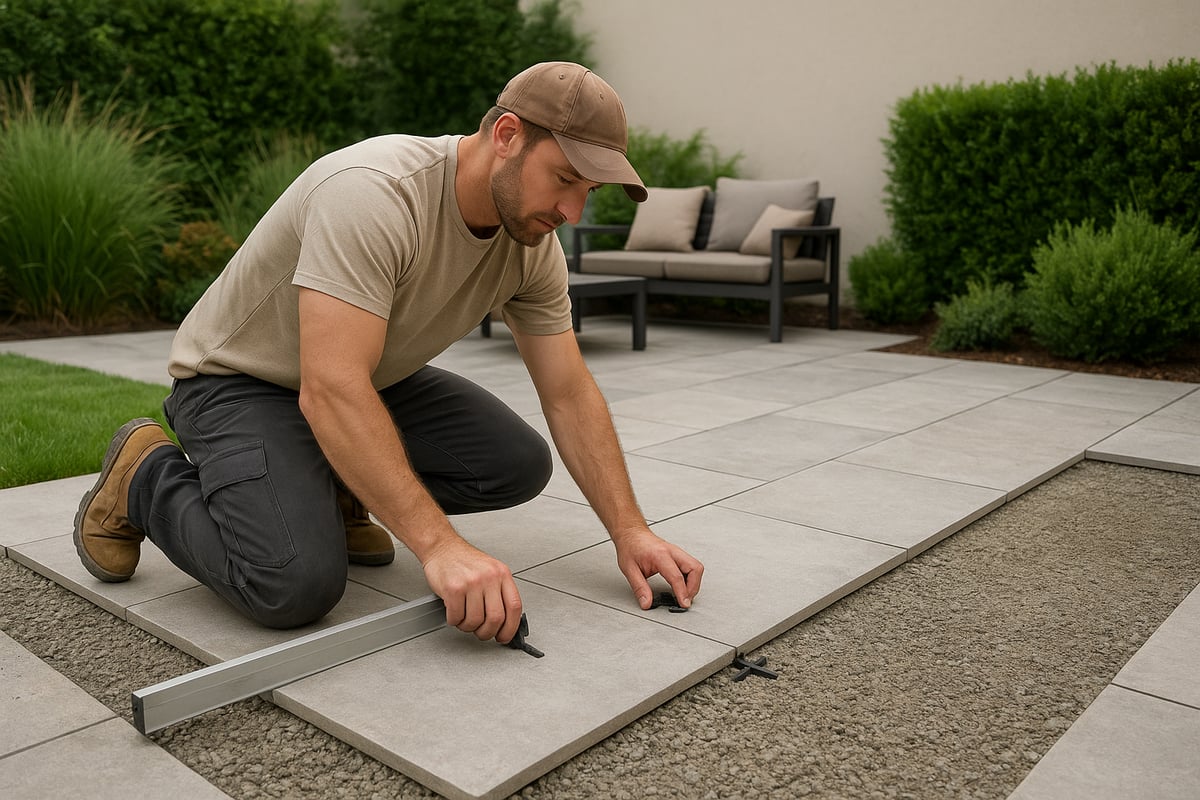Imagine stepping onto a stunning patio where timeless stone tiles create an inviting, sophisticated outdoor retreat. The right design transforms any backyard, balcony, or rooftop into a functional living space that endures for years.
This 2025 guide is your essential resource for outdoor patio stone tiles, offering expert advice on design, installation, and long-term care. Whether you are a homeowner, designer, or contractor, you will find practical strategies to achieve lasting style and performance.
Discover the latest tile trends, learn about material options, follow step-by-step installation tips, and gain insights on maintenance and costs. Ready to elevate your outdoor living? Let’s begin the journey to a beautiful, resilient patio.
Understanding Outdoor Patio Stone Tiles: Types, Benefits & Trends
Outdoor patio stone tiles are the foundation of stylish, lasting outdoor spaces. Understanding their types, advantages, and latest trends helps you make informed choices for your next project.

Stone Tile Types and Characteristics
There is a wide array of outdoor patio stone tiles available in 2025. Natural stone options include slate, granite, limestone, travertine, bluestone, sandstone, and marble. Each brings unique color, texture, and durability. Engineered alternatives, such as porcelain and concrete tiles, expertly mimic the look of natural stone while offering enhanced weather resistance.
Porcelain pavers, available in 2CM thickness, are especially popular for their frost resistance and versatility. All outdoor patio stone tiles must be evaluated for slip resistance, color consistency, and finish. Eco-conscious homeowners seek out locally sourced and recycled products for sustainability. According to industry reports, porcelain and natural stone remain the top choices for patios in 2025.
Benefits of Stone Tiles for Patios
Choosing outdoor patio stone tiles offers significant advantages over wood or composite materials. Their longevity means you can enjoy a beautiful patio for decades, with granite boasting lifespans of over 100 years outdoors. Maintenance is minimal, often requiring just sweeping and occasional washing.
Stone tiles deliver excellent return on investment, enhancing both property value and curb appeal. Their all-season performance includes superior freeze-thaw durability and UV resistance. Non-slip finishes are widely available, promoting safety in wet conditions. For homeowners prioritizing durability and value, outdoor patio stone tiles are a smart choice.
2025 Design Trends in Patio Stone Tiles
Design trends for outdoor patio stone tiles in 2025 reflect a blend of modern aesthetics and functional innovation. Large-format tiles and seamless layouts create a contemporary look, while mixed materials such as stone paired with wood, turf, or gravel add texture and interest.
Popular color palettes include earth tones, soft greys, and bold accent stones. Patterned installations, like herringbone, chevron, and modular grids, are rising in popularity. Integration with outdoor features such as fire pits and kitchens is also trending. For more inspiration and up-to-date styles, explore Patio tile design ideas. Surveys show 60% of new patios in 2024-2025 favor modular or mixed-material designs.
Choosing the Right Stone Tile for Your Space
Selecting outdoor patio stone tiles begins with evaluating your site’s climate and conditions. Freeze-thaw cycles, drainage, and sun exposure impact material choice. Match tile thickness and finish to expected foot traffic and use, such as using limestone in shaded patios or porcelain for exposed rooftops.
Budget considerations include material, installation, and ongoing maintenance. Always source from reputable suppliers and check for solid warranty coverage. Planning ahead ensures your outdoor patio stone tiles deliver beauty and performance suited to your needs.
Sustainability and Eco-Friendly Options
Sustainability is increasingly important when choosing outdoor patio stone tiles. Consider using recycled stone or materials sourced locally to reduce environmental impact. Permeable tile systems help manage stormwater and support eco-friendly landscaping.
Look for products that qualify for LEED or other green building certifications. Reclaimed bluestone is a popular option for heritage-inspired patios, combining character with responsible sourcing. With thoughtful choices, your outdoor patio stone tiles can support both your design goals and the environment.
Planning & Designing Your Outdoor Patio Stone Tile Project
Careful planning sets the stage for a successful outdoor patio stone tiles project. Each decision, from site evaluation to layout selection, shapes the final look, function, and longevity of your outdoor living space.

Site Assessment and Preparation
Start by thoroughly assessing your space for outdoor patio stone tiles. Measure the patio area, taking note of existing structures and any potential obstacles such as trees, garden beds, or utility lines.
Check the slope, as proper grading is crucial for water drainage. Experts recommend a 2% slope to prevent pooling.
Confirm local building codes and permits before breaking ground. Identify underground utilities to avoid costly mistakes.
A well-prepared base is the foundation for lasting results. For example, patios with poor drainage can suffer from erosion or frost heave, reducing the lifespan of your investment. Careful assessment ensures your project starts on solid ground.
Patio Layouts, Patterns, and Borders
The design possibilities for outdoor patio stone tiles are nearly endless. Popular layouts include grid, running bond, random, and modular patterns. Borders and accent tiles help define spaces and add visual interest.
Combining tiles of different sizes creates a custom look. Consider herringbone or chevron patterns for added slip resistance and style.
For a comprehensive overview of available materials and layout solutions, explore deck and patio flooring options.
Thoughtful pattern selection not only enhances aesthetics but also improves safety and functionality, ensuring your patio is as practical as it is beautiful.
Integrating Outdoor Features and Accessories
Incorporate features that complement your outdoor patio stone tiles, such as furniture, fire pits, and planters. Designate zones for dining, lounging, and cooking to maximize usability.
Plan pathways for accessibility, ensuring smooth transitions between areas. Recessed lighting between tiles can increase safety and ambiance after sunset.
Think about how your accessories interact with the tile layout. For example, placing planters at border edges can soften transitions and add greenery. Integrating features from the start creates a cohesive, inviting space that suits your lifestyle.
Budgeting and Timeline Planning
Effective budgeting is essential for any outdoor patio stone tiles project. Break down costs into materials, labor, sub-base preparation, and extras like edge restraints or lighting.
Account for delivery, waste removal, and sealing, which can impact the final price. Typical projects range from DIY installs that save on labor to professional jobs that offer faster, more precise results.
Project timelines vary, but most installations take one to two weeks. In Ontario, the average cost is $15-$40 per square foot, reflecting material choices and complexity. Careful planning helps avoid surprises and keeps your project on track.
Step-by-Step Installation Guide for Patio Stone Tiles
Transforming your outdoor space with outdoor patio stone tiles requires careful planning and precise execution. This guide walks you through each stage, so you can achieve a professional result that stands the test of time and weather.

Preparing the Base: Excavation and Sub-Base
The foundation of any outdoor patio stone tiles project is a stable, well-prepared base. Begin by marking the patio boundaries using stakes and string. Excavate the area to a depth of 6 to 8 inches, ensuring the surface is level and free of debris.
Next, install a compacted gravel base. Use a plate compactor to achieve a solid, even layer. This step prevents settling and supports the weight of your outdoor patio stone tiles. Add a layer of coarse sand or mortar as a setting bed, ensuring a consistent thickness for easy tile leveling.
A properly prepared sub-base reduces the risk of shifting tiles by up to 80 percent. Always check for proper drainage, aiming for a minimum 2 percent slope away from structures to avoid water pooling.
Laying Out and Dry-Fitting Tiles
Before permanent installation, dry-fit your outdoor patio stone tiles. This allows you to fine-tune the layout, minimize tile cuts, and confirm your chosen pattern. Arrange tiles according to your design—whether grid, herringbone, or modular—leaving space for joints.
Use spacers to maintain consistent gaps between tiles. Adjust tile positions to accommodate curves or edges, ensuring a seamless transition to borders or existing structures. Dry-fitting also helps you identify any irregularities in tile size or shape, making adjustments easier before adhesive or mortar is applied.
Proper planning at this stage ensures a balanced, visually appealing patio and reduces material waste.
Installing the Tiles: Methods and Best Practices
There are several methods for installing outdoor patio stone tiles. The dry lay approach is popular for ground-level patios, while mortar-set or pedestal systems are preferred for rooftops and raised decks. Choose a method that suits your site and tile type.
If using mortar or adhesive, apply it evenly to the setting bed before placing each tile. Tap tiles gently with a rubber mallet, checking for level and consistent joint width as you go. For a deeper dive into installation materials and techniques, see the Paver Patio Guide: Materials, Design & Installation.
Work in small sections to maintain accuracy. Regularly step back to review the overall alignment and pattern. This attention to detail ensures your outdoor patio stone tiles are secure and visually cohesive.
Cutting and Shaping Tiles
Accurate cutting is essential for a polished finish with outdoor patio stone tiles. Tools such as wet saws, angle grinders, and tile nippers are commonly used. Always wear safety goggles, gloves, and a dust mask to protect yourself during the cutting process.
Carefully measure and mark each tile before cutting, especially for corners, curves, or obstacles like posts and drains. For complex shapes, make incremental cuts and test fit as you go. This approach reduces breakage and ensures each tile fits perfectly in its designated space.
Taking the time to cut and shape tiles correctly results in a clean, professional edge and seamless transitions throughout your patio.
Grouting and Jointing
After all outdoor patio stone tiles are in place, focus on the joints. Select a joint material that suits your patio needs—polymeric sand is ideal for weed prevention, while grout or decorative pebbles can enhance aesthetics.
Pour the jointing material into the gaps, then sweep and compact it thoroughly. Remove excess material from tile surfaces before it hardens to prevent stains. For added protection, consider sealing the joints to guard against water intrusion and weed growth.
Proper jointing not only improves durability but also enhances the overall appearance of your outdoor patio stone tiles.
Edging and Finishing Touches
Edge restraints are crucial for keeping outdoor patio stone tiles securely in place. Install edging materials along the perimeter to prevent tiles from shifting over time. Decorative borders or inlays can add a custom touch and help define the space.
Check the finished patio for correct slope to ensure effective drainage. Complete your project with a thorough cleaning, removing any dust or debris. Inspect the installation for levelness and consistent joints, making final adjustments as needed.
These finishing touches guarantee a long-lasting, attractive patio you can enjoy year-round.
Skyscapes: Ontario’s Outdoor Flooring Experts
For homeowners across Ontario seeking expert solutions for outdoor patio stone tiles, Skyscapes delivers luxury modular stone and porcelain tile systems. Their team provides end-to-end service, from design and supply to professional installation, tailored to patios, balconies, and rooftops.
Products are engineered for Canadian climates and meet condo compliance standards. Skyscapes’ in-house experts ensure precision installation and project accountability. They offer free consultations and custom design support to homeowners, builders, and designers alike.
Featured in Toronto Life and the Toronto Star, Skyscapes is trusted by thousands for quality outdoor patio stone tiles. Their commitment to durability, style, and client satisfaction makes them a top choice for transforming outdoor spaces.
Maintenance & Care: Keeping Your Stone Tile Patio Beautiful
A well-maintained patio is the secret to long-lasting beauty and value. Caring for your outdoor patio stone tiles not only preserves their appearance but also protects your investment for years to come. With the right maintenance routine, your patio will remain a welcoming, functional space in every season.

Routine Cleaning and Seasonal Maintenance
Regular cleaning is essential to keep outdoor patio stone tiles looking their best. Start by sweeping away leaves, dirt, and debris to prevent scratches or stains. For most messes, a simple rinse with water will suffice. For stubborn spots, use a pH-neutral cleaner that is safe for stone surfaces.
Seasonal deep cleaning is recommended, especially after winter or heavy use. This helps remove built-up grime, moss, or algae. Always test cleaners on a small area first to ensure they do not damage the stone. For more detailed advice, consult maintenance tips for outdoor tiles to develop a care routine tailored to your tile type.
By maintaining a regular cleaning schedule, you will enhance the longevity and beauty of your outdoor patio stone tiles.
Sealing and Protecting Stone Tiles
Sealing natural stone is a vital step in protecting outdoor patio stone tiles from moisture, stains, and weathering. Choose a high-quality sealer that matches your specific tile type, such as granite, limestone, or porcelain. Apply sealers as recommended by the manufacturer, usually once a year or every other year.
Before sealing, ensure the tiles are completely clean and dry. Use a roller or brush for even coverage, and allow sufficient drying time. Watch for signs that resealing is needed, such as water no longer beading on the surface or increased staining.
Proper sealing helps outdoor patio stone tiles resist the effects of rain, sun, and daily use, maintaining their color and texture for years.
Dealing with Common Issues: Stains, Cracks, and Efflorescence
Even with the best care, outdoor patio stone tiles can develop stains, cracks, or a white powdery residue called efflorescence. Address oil, rust, or organic stains quickly using appropriate cleaners. For organic stains, a paste of baking soda and water can be effective.
Cracked or chipped tiles should be replaced promptly to prevent further damage. If you notice efflorescence, gently brush the residue away and ensure proper drainage to reduce recurrence. Avoid harsh chemicals that may harm stone surfaces.
Timely repairs and attentive care help preserve both the appearance and safety of your outdoor patio stone tiles.
Weed, Moss, and Pest Prevention
Weeds, moss, and pests can detract from the look and function of outdoor patio stone tiles. Fill joints with polymeric sand or grout to block weed growth and deter insects. Inspect your patio regularly for signs of moss or algae, especially in shaded or damp areas.
For natural moss removal, pour boiling water over affected spots and gently scrub with a brush. Avoid using salt or harsh chemicals, which can damage tiles and surrounding plants. Consider natural deterrents like vinegar for light infestations.
Consistent prevention and quick action keep outdoor patio stone tiles clean, safe, and visually appealing.
Winterizing Your Stone Tile Patio
Proper winterization ensures your outdoor patio stone tiles withstand harsh weather. Sweep away debris before the first freeze and avoid using salt or deicing chemicals that can harm stone and grout. Cover or store outdoor furniture to prevent scratches and stains during winter months.
If possible, install breathable covers to protect the surface while allowing moisture to escape. A well-prepared patio will resist freeze-thaw cycles, minimizing cracking or shifting. Data shows that winterizing can extend patio life by up to 30 percent.
Taking these simple steps each fall protects your outdoor patio stone tiles and preserves their beauty year after year.
When to Call a Professional
Sometimes, professional help is the best solution for maintaining outdoor patio stone tiles. Signs you need an expert include widespread tile shifting, persistent drainage issues, or extensive cracking. Large-scale repairs or full tile replacements require specialized skills and equipment.
Consider professional cleaning or resealing services for deep stains or stubborn grime. Many companies offer maintenance contracts, providing regular inspections and care for busy homeowners. Relying on professionals ensures your outdoor patio stone tiles remain safe, beautiful, and structurally sound.
By recognizing when to seek help, you safeguard your patio’s value and performance for the long term.
Cost, Value & Longevity: Making the Most of Your Investment
Investing in outdoor patio stone tiles is about more than just enhancing your home's appearance. Understanding the cost, value, and longevity of these materials will help you make informed decisions that benefit your property for years to come. This section breaks down the key factors to consider, from initial pricing to long-term returns.
Cost Factors: Materials, Installation, and Extras
When planning your outdoor patio stone tiles project, cost is a primary consideration. Material prices vary widely: slate and sandstone typically range from $10 to $25 per square foot, while granite and premium porcelain tiles can reach $18 to $35 per square foot installed. Labor costs depend on project complexity, site access, and installation method. Extras such as edge restraints, integrated lighting, and advanced drainage solutions can add to your budget. For instance, a professionally installed porcelain patio averages $18 to $35 per square foot. Explore the porcelain paver benefits to understand why these tiles are a top choice for performance and value in 2025.
Maximizing Return on Investment
Outdoor patio stone tiles are a strategic investment for homeowners seeking long-term value. These surfaces not only elevate curb appeal but also increase property value. Real estate experts note that premium outdoor finishes often yield an 80% or higher return on investment during resale. Unlike wood or composite options, outdoor patio stone tiles offer superior durability and timeless style, ensuring your space remains attractive and functional for decades. Choosing quality materials and professional installation further enhances your return, making these patios a wise financial decision for any property.
Comparing Stone Tiles to Other Patio Materials
Selecting the right patio material involves weighing durability, maintenance, and aesthetics. Here's a quick comparison:
| Material | Lifespan | Maintenance | Cost (per sq. ft.) |
|---|---|---|---|
| Stone Tiles | 30–100 years | Low | $10–$35 |
| Wood | 10–30 years | High | $8–$25 |
| Composite | 15–25 years | Medium | $12–$30 |
| Concrete | 20–40 years | Medium | $6–$20 |
Outdoor patio stone tiles outperform wood and composite in harsh climates, lasting two to three times longer and requiring less upkeep. Their versatility in design and finish also means they can be tailored to suit any outdoor setting, giving you both beauty and resilience.
Longevity and Warranty Considerations
The lifespan of outdoor patio stone tiles depends on the material, installation quality, and local climate. Natural stone patios can last 30 to 100 years, while premium porcelain tiles often come with 15-year warranties. Always verify manufacturer and installer warranty coverage before purchase. Regular maintenance, proper drainage, and high-quality installation are key to maximizing longevity. For example, a well-maintained granite patio can easily surpass a century of service, making it a legacy feature for your home.
Expert Tips & FAQs for Patio Stone Tile Success
Unlocking the full potential of your outdoor patio stone tiles project requires expert knowledge and careful planning. From choosing materials to long-term care, these insights will help you achieve stunning, durable results with confidence.
Pro Tips for a Flawless Patio Tile Project
Start with a detailed plan for your outdoor patio stone tiles. Always account for expansion joints to manage temperature changes and prevent cracking. Mix tiles from multiple boxes to ensure color consistency across your space.
Use a laser level for precise alignment and maintain proper drainage by incorporating a gentle slope away from structures. For best results, schedule installation during mild, dry weather.
When working with porcelain tiles, follow Professional Tips for Installing Outdoor Porcelain Pavers for guidance on adhesives, cutting, and jointing. These steps will help you avoid common pitfalls and ensure your outdoor patio stone tiles last for years.
Frequently Asked Questions (FAQs)
Can you install outdoor patio stone tiles over an existing concrete slab? Yes, if the concrete is stable, level, and free of major cracks. Are outdoor patio stone tiles slippery when wet? Most quality tiles offer textured, non-slip surfaces, but always check the slip rating before purchase.
How do you prevent weeds from growing between tiles? Use polymeric sand or grout in joints to block weed growth and maintain a clean appearance. What is the best way to clean natural stone tiles? Use pH-neutral cleaners and avoid harsh chemicals to protect the finish and color of your outdoor patio stone tiles.
Troubleshooting Common Problems
Uneven tiles or lippage can occur if the base is not properly compacted or leveled. To fix this, lift the affected tile, adjust the base, and reset it. If you notice water pooling, check for proper slope and clear any blocked drainage.
Loose or rocking tiles may indicate sub-base issues. Remove the tile, re-compact the base, and reinstall. If joints deteriorate or weeds appear, clean out the old material and refill with fresh polymeric sand to keep your outdoor patio stone tiles stable and attractive.
Resources and Where to Learn More
Expand your expertise with manufacturer installation guides and video tutorials tailored to outdoor patio stone tiles. Explore directories of certified suppliers and installers for trusted professionals in your area.
Consider industry associations like the National Tile Contractors Association and Landscape Ontario for best practices and networking. For comprehensive care strategies, consult the 2025 Hardscape Maintenance Guide to ensure your outdoor patio stone tiles remain beautiful and resilient year after year.







